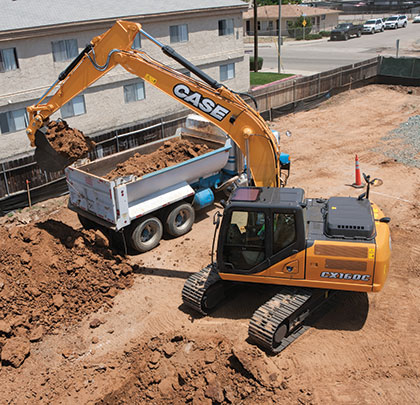Most heavy equipment manufacturers have narrowed their Tier 4 Final solutions to two options. One is Selective Catalytic Reduction (SCR). Using SCR technology allows the engine to create less PM and treats exhaust gases with diesel exhaust fluid (DEF) to eliminate pollutants. The other option is Cooled Exhaust Gas Recirculation (CEGR). CEGR recirculates exhaust into the engine to reduce NOx formation, while using a diesel particulate filter (DPF) to capture pollutants.
Each manufacturer’s proprietary technologies and emissions compliance strategies will evolve as companies work to further reduce emissions and save on fuel. Over time, manufacturers will also introduce innovations to their equipment lines to enhance their performance. What doesn’t change is whether SCR or CEGR is more suitable for a machine based on the equipment’s design, operating characteristics, and application requirements. In this article we’ll look at five key product categories (wheel loaders, excavators, dozers, backhoes, and skid steers) and how Tier 4 solutions match up with their applications.
WHEEL LOADERS
These machines, by nature, create inconsistent engine loads and emissions output. Horsepower output and the ability to create breakout force also have a major impact on performance. Given these operating characteristics, SCR is well suited for wheel loaders because it’s an after-treatment system that lets the engine do what it is designed to do: generate power at varied engine loads. The technology also doesn’t require the use of regeneration to burn off accumulated particulates for faster throttle response time. The end result is full power and breakout force when needed. Additionally, SCR engines are optimized to create an efficient combustion process. The technology can actually improve performance because the engines breathe more freely, which in turn, results in significant fuel savings. There is also no need for a diesel particulate filter, which reduces long-term maintenance costs. Overall, SCR is an inherently simple solution with minimal components. It’s easy to maintain, and it works with standard cooling systems, oils, and diesel fuels.
EXCAVATORS
Unlike wheel loaders, excavators are used extensively for digging and lifting. Engine loads, and therefore engine speeds, are more consistent. The result is relatively steady combustion temperatures and emissions. Given these characteristics, a CEGR system is appropriate because a portion of the exhaust gases are cooled and blended with fresh air, then circulated back into the combustion chamber to lower combustion temperature, which in turn, reduces NOx. An after-treatment DPF system can then be used to reduce PM. CEGR provides a user-friendly solution without any change in the operation of the machines common with more traditional technologies.
CRAWLER DOZERS
Dozers are similar to excavators in that they rely on brute force and raw power to move material, which would suggest they’re excellent candidates for CEGR. However, an important distinction is that dozers and excavators tackle the load differently. An excavator’s hydraulics handle the majority of the machine’s lifting and moving. On a dozer, the transmission is the primary mechanism that exerts the power needed to push the load in the forward direction. As the dozer backs up to prepare for another forward push of material, the load is taken off the machine. The result is inconsistent engine loads and emissions output much like those encountered with a wheel loader. As such, SCR is well suited for dozers because it lets the engine run at peak performance without compromising power or drawbar pull required to move material when it’s needed most. At the same time, the technology allows for significant gains in fuel efficiency.
LOADER BACKHOES
Like wheel loaders, loader backhoes experience inconsistent engine loads and emissions based on the variety of work they perform. This would suggest the use of SCR for emissions control. Yet, a major advantage of a backhoe is the agility it offers with transportability, as well as when digging and lifting heavy loads. It’s a work environment that puts a premium on a smaller engine size in addition to a streamlined chassis. As such, some manufacturers enlisted electronic controls to develop Tier 4i-certified machines with smaller engines that use CEGR technology. The result is a maneuverable machine with good visibility and the power and torque required of a backhoe—all while conserving fuel and meeting emissions standards.
SKID STEER LOADERS
Skid steers offer a different wrinkle to the conversation. Operators typically run these machines at consistent speeds, producing the consistent combustion heat needed to decrease PM. A skid steer also has a lower purchase price when compared with larger machines, which means the addition of SCR technology has a greater impact on the overall cost of the equipment. CEGR is typically the right technology for this application based on overall value to the user and the machine’s operating characteristics.
There is a third option, however, when it comes to skid steers: CEGR with a catalyst-only solution. Because skid steers are commonly used by contractors with large fleets, as well as rental fleets, the machines may have various operators and move around between jobsites regularly. Using the maintenance-free CEGR with catalyst-only solution for these models provides convenience and efficient operation. Skid steers will continue to be a market where equipment size and application determines Tier 4 solutions and, as such, will see considerable variety. ■
About the Author:
Brad Stemper is a solutions marketing manager with CASE Construction Equipment. For more information on the CASE equipment, visit www.casecs.com.
_________________________________________________________________________
Modern Contractor Solutions, October 2013
Did you enjoy this article?
Subscribe to the FREE Digital Edition of Modern Contractor Solutions magazine.

Paired by Design


